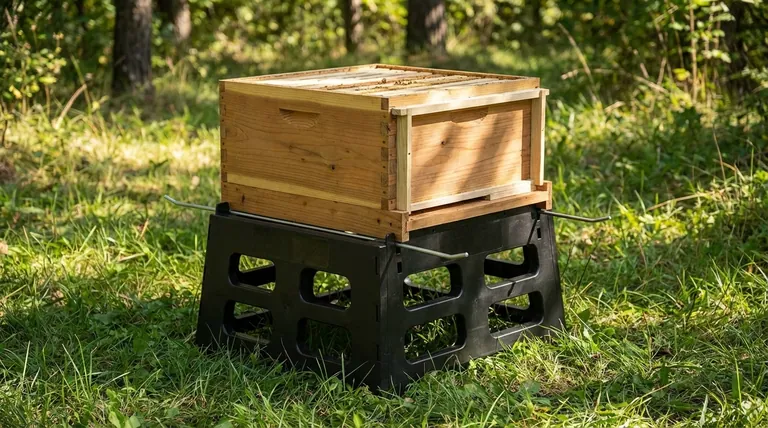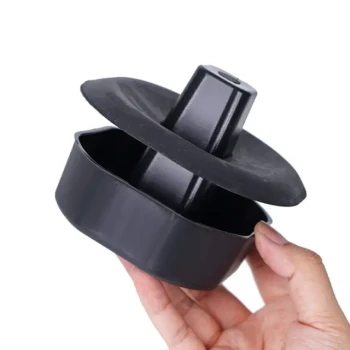While not strictly mandatory, a hive stand is a fundamental piece of equipment that is highly recommended for virtually every beekeeper. It elevates the hive off the ground, which is a simple action that solves numerous problems related to hive health, pest management, and the physical demands of beekeeping. Forgoing a stand creates preventable work and exposes your colony to unnecessary risks.
The question isn't whether a hive can survive without a stand, but why you would knowingly subject it—and yourself—to the challenges of a ground-level setup. A hive stand is a strategic investment in hive health, equipment longevity, and your own physical well-being.

The Core Functions of a Hive Stand
A hive stand is more than just a platform; it's a tool that actively improves the environment for your bees and makes your job as a beekeeper significantly easier.
Protecting Your Hive from Moisture
A hive placed directly on the ground will absorb moisture. This constant dampness promotes wood rot, drastically shortening the life of your woodenware, particularly the bottom board.
A damp hive environment also forces the bees to expend more energy to regulate internal temperature and humidity, adding unnecessary stress to the colony.
Improving Hive Ventilation and Health
Elevation allows for crucial airflow underneath the hive. This circulation helps keep the bottom board dry, reducing the risk of mold and fungus that can harm the colony. A dry hive is a healthier hive.
Enhancing Pest and Predator Defense
Raising your hive even a few inches off the ground creates a significant barrier for common pests. It makes it more difficult for ants and other crawling insects to establish a trail into the hive.
It also helps deter larger pests like skunks, which tend to scratch at ground-level entrances to provoke and eat bees, and mice, which may try to nest inside the hive during winter.
Easing the Strain on the Beekeeper
This is a critical benefit that is often overlooked. Beekeeping involves lifting heavy boxes, with honey supers often weighing 50 pounds or more. Bending over to lift that weight from the ground is a direct path to back strain.
A stand that raises the hive to a comfortable working height makes inspections, maintenance, and harvesting far more manageable and sustainable over the long term.
Keeping the Entrance Clear
A hive on the ground is susceptible to having its entrance blocked by growing grass, weeds, or fallen leaves. In winter, snow can easily cover the entrance. An elevated entrance ensures the bees have a clear flight path for foraging and ventilation.
Understanding the Trade-offs of Forgoing a Stand
Choosing not to use a stand may seem like a way to save a small amount of money or effort upfront, but it introduces several distinct disadvantages.
Increased Equipment Degradation
The primary consequence is financial. Bottom boards in direct contact with damp soil will degrade much faster than elevated ones, forcing you to spend money on replacements.
Greater Pest Pressure
A ground-level hive is an open invitation to pests. You will likely spend more time and effort implementing other pest-control measures that could have been mitigated by simple elevation.
Risk of Physical Strain
The ergonomic cost is significant. Regularly lifting heavy hive components from an awkward, low position dramatically increases your risk of injury, which can compromise your ability to manage your bees effectively.
Making the Right Choice for Your Apiary
The goal is elevation; the specific method can be adapted to your budget and needs. A "stand" can range from a purpose-built product to simple, readily available materials. You can use cinder blocks, wooden pallets, or a custom-built frame from scrap lumber.
- If your primary focus is hive health: Use a stand to guarantee protection from ground moisture and improve critical airflow.
- If your primary focus is beekeeper comfort: Use a stand that raises the bottom of the hive to at least knee-height to prevent back strain.
- If your primary focus is budget: Use two or four cinder blocks as a simple, cheap, and highly effective stand that provides all the core benefits.
Ultimately, elevating your hive is a foundational decision that pays dividends in bee health, equipment longevity, and your own enjoyment of beekeeping.
Summary Table:
| Benefit | Key Advantage |
|---|---|
| Moisture Protection | Prevents wood rot & dampness in the hive |
| Pest & Predator Defense | Deters ants, skunks, and mice |
| Improved Ventilation | Enhances airflow for a healthier colony |
| Beekeeper Ergonomics | Reduces back strain from heavy lifting |
| Clear Hive Entrance | Keeps flight path unobstructed by grass or snow |
Ready to build a healthier, more manageable apiary? At HONESTBEE, we supply durable, wholesale-focused beekeeping supplies and equipment to commercial apiaries and distributors. A quality hive stand is a foundational investment in your operation's success. Let us help you equip your beekeeping business for maximum efficiency and hive health.
Contact HONESTBEE today to discuss your wholesale needs!
Visual Guide

Related Products
- Plastic Bee Hive Stand for Beekeeping
- Professional Engraved Round Hive Number Tags for Beekeeping
- Professional Ant-Proof Beehive Stand with Integrated Moat for Beekeeping
- Wholesales Dadant Size Wooden Bee Hives for Beekeeping
- Professional Galvanized Hive Strap with Secure Locking Buckle for Beekeeping
People Also Ask
- What are the advantages of a second hive if the queen is killed? The Ultimate Insurance Policy for Your Apiary
- How does the longevity of plastic bee hives compare to wooden hives? Discover the Durable Choice
- Why is it important to level a hive stand properly? Prevent Catastrophic Failure & Ensure Hive Health
- How do bees regulate the temperature of their hive during the summer? Discover Their Natural Cooling System
- What is the purpose of a hive stand in a Langstroth hive? Protect Your Hive and Boost Colony Health



















